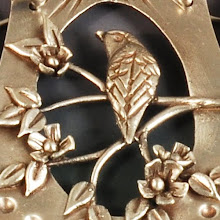A common platitude for artists is that working in a series fosters development of the work. The series may be performed in parallel, simultaneously working on several pieces, or in series, completing one after another. In either case, an idea generated by one version influences the next. This provides relief to the artist - we don't have to incorporate every trick we know into one piece, but can experiment with one or two ideas at a time and hopefully get a better handle on how to incorporate them going forward.
 |
Anemone Drop earrings
©2012 Vickie Hallmark
sterling clay, Argentium wire |
As I play with the notion of components, I've tried fusing them onto Argentium and pasting them together in the clay state. Today I have several pairs of earrings influenced by a repeat of my Flock bracelet currently under construction. I love the sinuous movement given to the links by an attractive set of beaded linkages. Most jewelry designers would use jump rings, but I like the design element introduced by the beaded heads of these connectors.
 |
Bird & Nest earrings
©2012 Vickie Hallmark
sterling clay, Argentium wire |
To get beautiful beads, I always use Argentium sterling, which balls up without the ugly wrinkling seen on conventional sterling wire. The first bead is easy to do on the bare wire. The second bead is tricky, because the other components in contact with the wire draw heat away, making it quite difficult to get the wire hot enough. There are two tricks to making this work well - one is Argentium, which heats more locally than regular sterling, and the other is the right torch. A small, tight, very hot flame gets in and out before the silver transmits the heat to its neighbors. Argentium also has the added advantage of heat hardening. After I get the beaded linkages all completed, the jewelry goes into the kiln at 570
° F for a couple of hours to increase the hardness far beyond that of regular work-hardened sterling. Thus the wires, while not the typical jump rings, are beautiful and sturdy as well.
























